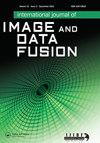将Sentinel-2和WorldView-4图像融合在Sentinel-3光谱带值上的质量评估:以克罗地亚萨格勒布为例
IF 1.3
Q3 REMOTE SENSING
International Journal of Image and Data Fusion
Pub Date : 2020-01-02
DOI:10.1080/19479832.2019.1683624
引用次数: 3
摘要
摘要图像融合方法旨在融合低分辨率和高分辨率图像,获得为特定应用提供新信息的新图像。本文的主要目标是使用单个WorldView-4卫星图像进行Sentinel-2图像的多时相融合,用于城市区域监测。融合这些图像应该为Sentinel-2图像提供与原始Sentinel2图像相似的辐射波段值,但空间分辨率为WorldView-4。采用Ehlers、Brovey变换、改进的强度-色调饱和、高通滤波、超球面色彩空间和小波分辨率合并融合技术对Sentinel-2图像进行了空间增强。首先使用标准统计参数、平均值、中值和标准差对原始图像和融合图像进行比较。使用不同的客观图像质量指标进行图像质量分析,如均方根误差、峰值信噪比、通用图像质量指数、结构相似性指数、相对无量纲全局误差、空间相关系数、相对平均光谱误差、光谱角映射器、多尺度结构相似性指标。使用这些质量度量有助于确定融合图像的光谱和空间保存。基于标准统计参数和质量测量,超球面颜色空间方法被选为Sentinel-2和WorldView-4图像融合的最佳方法。本文章由计算机程序翻译,如有差异,请以英文原文为准。
Quality assessment of fusing Sentinel-2 and WorldView-4 imagery on Sentinel-2 spectral band values: a case study of Zagreb, Croatia
ABSTRACT Image fusion methods aim at fusing low resolution and high-resolution image to obtain a new image that provides new information for the specific application. The main goal of this article is multitemporal Sentinel-2 image fusion using single WorldView-4 satellite image for urban area monitoring. Fusing those images should provide Sentinel-2 image with similar radiometric band value as original Sentinel-2 image, but with a spatial resolution of WorldView-4. Ehlers, Brovey Transform, Modified Intensity-Hue-Saturation, High-Pass Filtering, Hyperspherical Colour Space and Wavelet resolution merge fusion techniques were used for spatial enhancement of Sentinel-2 images. Original and fused images were first compared using standard statistical parameters, mean, median and standard deviation. Image quality analysis was conducted with different objective image quality measures like root mean square error, peak signal to noise ratio, universal image quality index, structural similarity index, relative dimensionless global error, spatial correlation coefficient, relative average spectral error, spectral angle mapper, multi-scale structural similarity index. Using these quality measures helped in determining the spectral and spatial preservation of fused images. Hyperspherical colour space method was selected as the best method for image fusion of Sentinel-2 and WorldView-4 image-based on standard statistical parameters and quality measures.
求助全文
通过发布文献求助,成功后即可免费获取论文全文。
去求助
来源期刊

International Journal of Image and Data Fusion
REMOTE SENSING-
CiteScore
5.00
自引率
0.00%
发文量
10
期刊介绍:
International Journal of Image and Data Fusion provides a single source of information for all aspects of image and data fusion methodologies, developments, techniques and applications. Image and data fusion techniques are important for combining the many sources of satellite, airborne and ground based imaging systems, and integrating these with other related data sets for enhanced information extraction and decision making. Image and data fusion aims at the integration of multi-sensor, multi-temporal, multi-resolution and multi-platform image data, together with geospatial data, GIS, in-situ, and other statistical data sets for improved information extraction, as well as to increase the reliability of the information. This leads to more accurate information that provides for robust operational performance, i.e. increased confidence, reduced ambiguity and improved classification enabling evidence based management. The journal welcomes original research papers, review papers, shorter letters, technical articles, book reviews and conference reports in all areas of image and data fusion including, but not limited to, the following aspects and topics: • Automatic registration/geometric aspects of fusing images with different spatial, spectral, temporal resolutions; phase information; or acquired in different modes • Pixel, feature and decision level fusion algorithms and methodologies • Data Assimilation: fusing data with models • Multi-source classification and information extraction • Integration of satellite, airborne and terrestrial sensor systems • Fusing temporal data sets for change detection studies (e.g. for Land Cover/Land Use Change studies) • Image and data mining from multi-platform, multi-source, multi-scale, multi-temporal data sets (e.g. geometric information, topological information, statistical information, etc.).
 求助内容:
求助内容: 应助结果提醒方式:
应助结果提醒方式:


